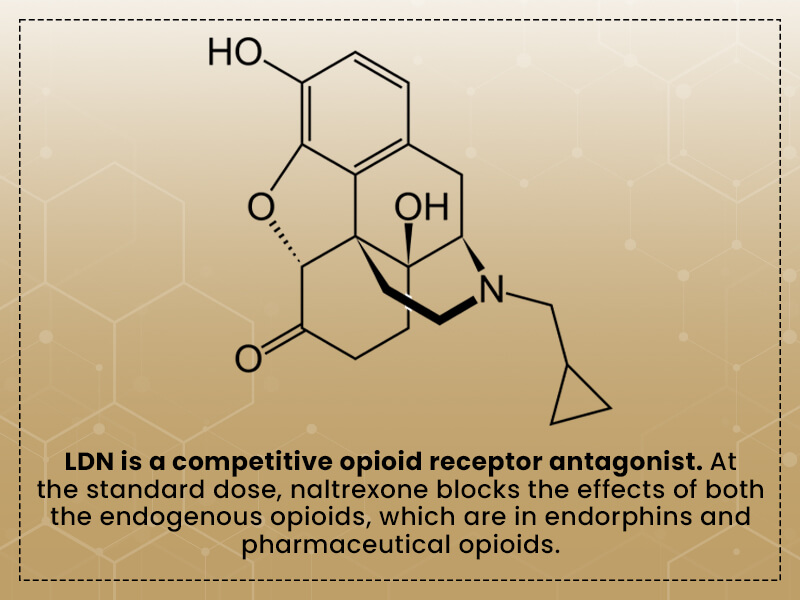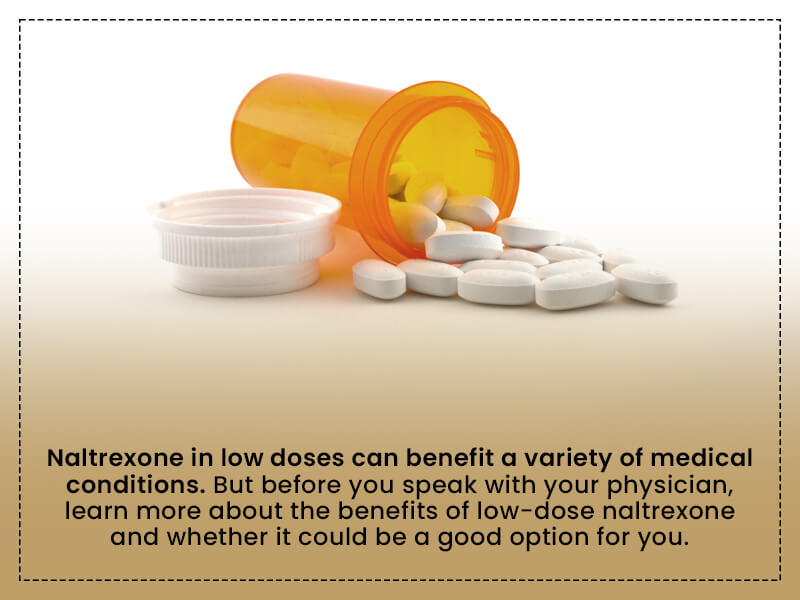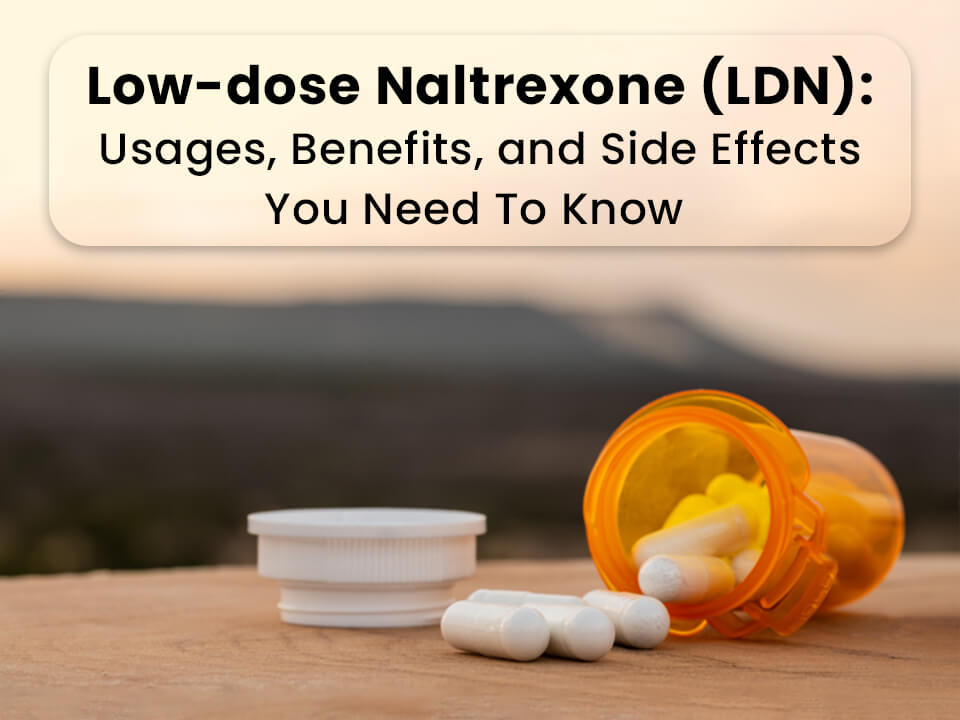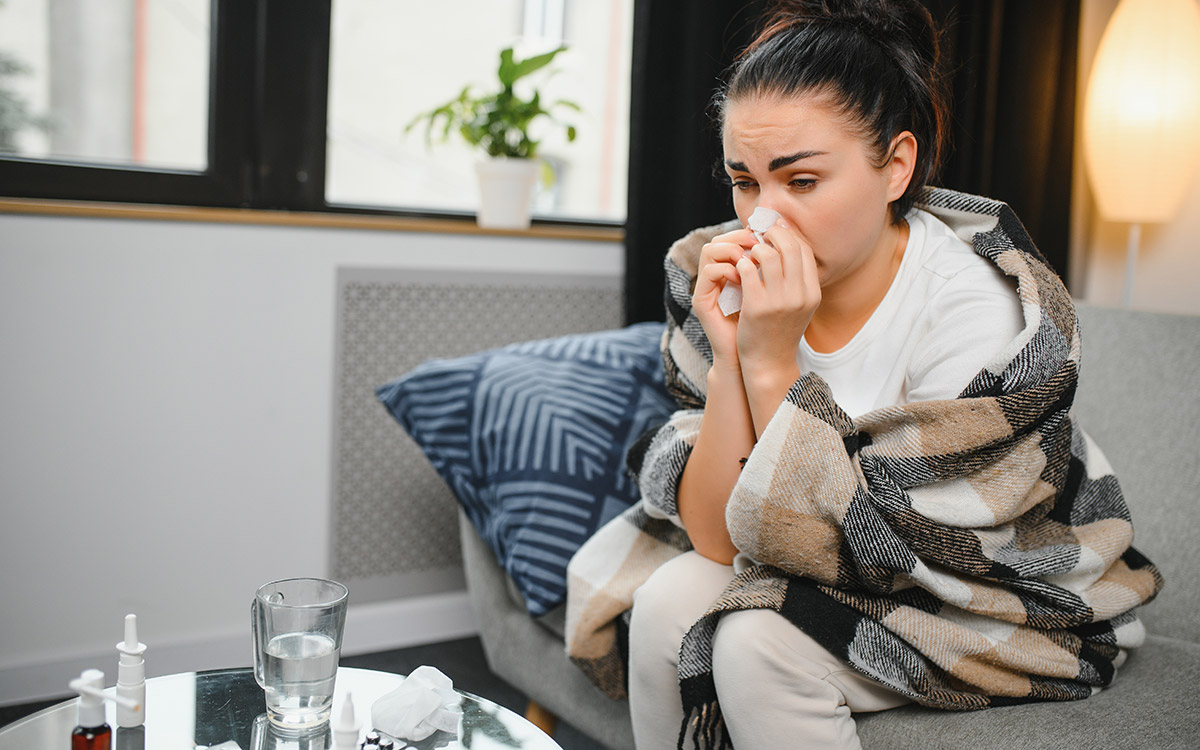Low-dose Naltrexone (LDN) is a medication that has become increasingly popular in recent years for its many potential uses and health benefits. It’s typically used to treat opioid addiction, but it can also be used off-label for conditions such as autoimmune diseases, chronic pain, anxiety, and more. But what is low-dose naltrexone, and what are its benefits? What are the potential side effects? These are some of the questions we’ll explore in this article.
What Is Low-dose Naltrexone?

In 1984 Naltrexone was approved by the FDA in the USA for the treatment of opioid addiction, used at the standard dose of 50 mg to 100 mg per day. It’s a pure opioid receptor antagonist.
LDN is a pure inhibitor, so there is no narcotic effect. The chemical structure is almost identical to the endorphins that we make naturally called met-enkephalin, also known as OGF or opioid growth factor.
LDN is an antagonist of the OGF receptors, and there are OGF receptors on a wide range of cells in the body. When we talk about low-dose naltrexone, we’re referring to doses that are a 10th or less of the standard dose of naltrexone. Most of the research studies have used 4.5 mg per day. Doses range from 0.001 mg – 16 mg in clinical practice.
Low-dose naltrexone binds to the endorphin receptors for about 1 – 1/2 hours, and the blockade lasts about 4 – 6 hours. Its effects are analgesic and anti-inflammatory. One of the other effects is that it increases the production of your endorphins.
Research into the effects of LDN began in the 1980s by Dr. Ian Zagon and Dr. Patricia McLachlan at Penn State. Dr. Bernard Bihari, in New York, pioneered using LDN in clinical practice. In the mid-1980s, he was using it to treat HIV in his patients. His patients were taking naltrexone for their opioid addictions, and as he weaned them off it, he noticed positive side effects with other conditions and symptoms. He was a Harvard-trained physician with a specialist in neurology. He was running the New York State health department and, therefore, was aware of the research that was going on and tried it out for clinical use.
The first published human trial was in 2007 by Dr. Jill Smith, and it was a study for Crohn’s disease.
- Naltrexone exists in a racemic mixture of isomers (“left-handedness and right-handedness”).
- Dextro-naltrexone binds toll-like receptors (TLR).
- Levo-naltrexone binds to opioid receptors.
Dextro-naltrexone
- Antagonist effect at Toll-like receptors (TLR).
- TLR-4 receptors exist on microglial cells, other macrophages, mast cells
- Activated microglial cells produce proinflammatory cytokines, substance P, and nitric oxide.
- Inhibition leads to a decreased proinflammatory cascade.
Levo-naltrexone
- Antagonist effect on opioid receptors.
- Small temporary opioid blockade.
- Upregulates endogenous opioid production.
- Upregulates opioid receptors.
- Increased endorphins are favorable to the immune system.
Endorphins are natural peptides produced in many cells that regulate cell growth, including your immune cells. Many patients who have autoimmune disease tend to have low levels of endorphins, Met-enkephalin, aka opioid growth factor (OGF), an important immunomodulatory. Opioid receptors are in the central and the peripheral nervous system, the GI tract, and on lymphocytes. By using LDN, you receive a brief blockade, creating a rebound effect giving you more endorphins, including OGF, and increased production of the OGF receptors.
Benefits of Low-dose Naltrexone

Naltrexone is a drug that has been used to help people recover from addictions, specifically opioid and alcohol abuse. The dosage for this type of treatment is typically 50 mg per day over twelve weeks.
But in lower doses, usually somewhere around 4.5 mg per day, naltrexone can also benefit a variety of other medical conditions because of the way naltrexone binds to opioid receptors in the brain, which produces endorphins.
Continue reading to learn more about the benefits of low-dose naltrexone, the ways you can take it, and how to get a prescription filled at a compounding pharmacy.
Conditions Low-dose Naltrexone Can Benefit
Low-dose naltrexone works by binding to the endorphin receptors in your brain. This makes your body produce more endorphins, which can control the body’s immune system and slow the production of unwanted cells that cause various medical conditions.
What is so fascinating about low-dose naltrexone is its ability to treat and alleviate systems of a wide variety of medical conditions, some of which include:
- Certain types of cancers, such as breast cancer
- Fibromyalgia
- Ulcerative colitis
- Crohn’s disease
- Cardiomyopathy
- Multiple sclerosis
- Rheumatoid arthritis
- Chronic pain
- Hashimoto’s thyroiditis
- Kawasaki’s disease
- Epstein Barr virus
- Pernicious anemia
- Lupus
- Scleroderma
Suppose you have a chronic pain condition, inflammation, autoimmune disease, or any other medical condition. In that case, it may be worth your time to discuss whether low-dose naltrexone could help to ease your symptoms and increase your quality of life.
What Are the Side Effects of Low-dose Naltrexone?
Side effects with low-dose naltrexone are uncommon because the dose is so low and has been reported by less than 8% of people. Low-dose naltrexone is unlikely to cause the same side effects as high-dose naltrexone. Side effects of LDN may include:
- Difficulty sleeping (insomnia).
- Nausea.
- Nightmares or wild dreams.
- Rarely, prolonged erections (priapism).
- Rarely, weight loss.
Difficulty sleeping initially was reported by approximately 8% of people receiving low-dose naltrexone, but this resolved within two weeks in most people. Other side effects (such as nausea and wild dreams) were reported by less than 1% of people.
Low-dose naltrexone is usually well tolerated with few side effects. Some people need a more gradual increase in their dosage to help them tolerate the drug. Low-dose naltrexone should be started at an extremely low dose, such as 1 to 1.5 mg/day, and the dosage should be increased by 1 mg every week to a maximum of 4.5 mg/day.
What Are the Long-term Side Effects of Low-dose Naltrexone?
The long-term side effects of low-dose naltrexone are unknown because research has not investigated what happens to people who take the medication long-term. However, naltrexone has a long history of safe use when used to treat opioid addiction.
Ways To Take Low-dose Naltrexone
One of the great things about having to obtain your low-dose naltrexone from a compounding pharmacy is that you will have options for how to deliver the medication to your body. For many, taking capsules is the first thought.
But it may come as a surprise to learn that low-dose naltrexone can be made into sublingual drops (placed underneath your tongue), topical creams and gels, injectables, tablets, and more, depending on your individual circumstances.
The purpose of a compounding pharmacy is to meet your unique needs, so when traditional capsules don’t work for you, King’s Pharmacy & Compounding Center can provide a better solution to increase the effectiveness of your low-dose naltrexone.
The Bottom Line
Low-dose naltrexone has found success in treating a wide range of illnesses and conditions, making it one of the most popular alternative treatments available today. It can offer tremendous benefits when taken correctly and under the advice of a medical professional. If you think LDN may be the right treatment for you, reach out to your doctor. It could be the answer you’ve been searching for.
Do you need more information or guidance on how you can benefit from our compounded medicines? At King’s Pharmacy & Compounding Center, we want what’s best for your health and will work to find the right solutions for you. To learn more, visit https://kingspharma.com/.










